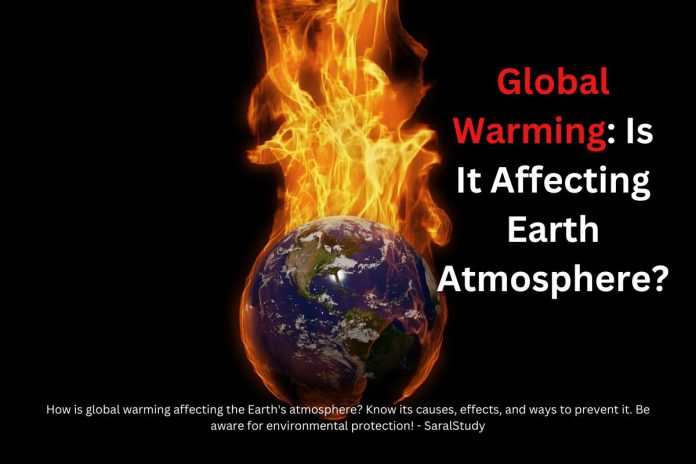Global warming is affecting the atmosphere of earth in a serious way. The Earth’s atmosphere is built of different gaseous layers. Sun rays reach the earth’s surface by traveling through the atmosphere. Similarly, the heat from the Earth’s surface travels the space after passing through the atmosphere.
The gases surrounding earth’s atmosphere will prevent all of heat from escaping back into the space. “Green House Gases” is the name given to them. These gases help in maintaining the temperature of the earth to the optimum levels. The composition of greenhouse gases should not be disturbed by any means as this prevents global warming and the entire phenomena associated with it.
Also Read: What is Global Warming? Causes, Effects & Solutions
What Happens During Global Warming
- The harmful UV rays will not be able to leave earth’s atmosphere as the increased carbon monoxide levels would not allow them to escape.
- The temperature begins to rise slowly and gradually and as the result of which the bio cycle of Earth’s atmosphere is disturbed. Polar ice caps begin to melt.
- The volume of fresh water making entry into the ocean and the level of ocean would substantially increase.
- The CO2 produced by humans creates a strong layer of gas around the earth. The layers allow the sun’s rays to enter into earth’s atmosphere, but does not let the heat to pass out.
- The heat gets trapped in the earth’s atmosphere and the temperature level begins to rise gradually over a period of time.
How Global Warming Affects Earth’s living Creatures
When there is global warming, the living creatures as well as human beings begin to see the potential danger. There are several ramifications associated with global warming phenomena that directly or indirectly affect living creatures on the earth. These include:
- The chances of evolution of living creatures will diminish so quickly that they will not be able to adapt.
- Since the environment around begins to change unnoticeably, living creatures face extinction.
- With temperature rising, living beings will have the problem to sustain. After the threshold temperature is reached, the living beings start suffering quietus.
Effects of Global Warming on Earth’s Atmosphere
Global warming has become a serious global problem, mainly caused by human activities. The burning of fossil fuels, deforestation, and industrial processes are increasing the amount of greenhouse gases in the atmosphere. In particular, gases such as carbon dioxide (CO₂) are increasing the Earth’s temperature by trapping the sun’s heat, causing climate change.
Temperature Increase
According to scientific studies, the Earth’s average temperature has been rising at a rate of 0.11°F (0.06°C) per decade since 1850, and has increased by a total of more than 2°F so far. However, since 1982, this rate has accelerated three times and has now reached 0.36°F (0.20°C) per decade.
2023 will be the hottest year ever, 2.12°F (1.18°C) higher than the average temperature of the 20th century (57.0°F or 13.9°C). It was also 2.43°F (1.35°C) higher than the average temperature before the Industrial Revolution (1850-1900).
The most worrying fact is that the last 10 warmest years (2014-2023) have been recorded in the recent decade itself, which shows the increasing effects of climate change. Data source: National Centers for Environmental Information (NCEI)
Weather instability:
Climate change is increasing the incidence of extreme heat waves, intense rainfall, floods and droughts. Changes in monsoon patterns are having a negative impact on agriculture.
Melting of glaciers and polar ice:
The ice of the Arctic and Antarctica is melting rapidly, causing sea levels to rise. If this trend continues, problems of flooding and population displacement may arise in coastal areas.
Ocean Acidification:
The acidity of the oceans is increasing due to the high amount of CO₂ dissolved in the atmosphere, which is adversely affecting marine life. Coral reefs are also being destroyed by this change.
Effect on biodiversity:
Many species of wildlife and plants are on the verge of extinction due to climate change. The food chain is also being affected due to imbalance in the ecosystem.
How to Reduce the Effects of Global Warming
Here are 11 easy ways, we can help reducing the effects of global warming. Some of them are so easy ways/steps that even a student or a children can follow.
- Plant trees in your area and in the lawn area of your home. Trees help in absorbing CO₂. It is very important to plant more and more trees and prevent deforestation.
- It is very important that you use the recycle paper as this will put less stress on the environment.
- Go for light cotton clothing on the very hot summer days, instead of sitting in air conditioned room.
- Just go for the Full Laundry Cleaning Process.
- In winters, do not go for room heating, instead wear woolen clothes.
- Instead of taking your personal car, make it a habit to go by bus. If the distance is short, it is always better to walk.
- Switch off the lights in your home if you do not require them.
- Eat less processed and non-vegetarian food. It is always healthy to maintain a healthy and vegetarian diet.
- Try drinking from tap water. Prefer not to use bottled water.
- Reduction in greenhouse gas emissions by using renewable energy sources (solar and wind energy), improving energy efficiency and adopting clean technologies.
- Making people aware and implementing strict environmental policies by governments is essential to tackle this problem.
Conclusion
Global warming is taking the toll and every individual and collective effort should be made. It is not just an environmental problem, but it has become a global crisis. If we are not cautious now, it can have even more serious consequences in the future. It is the responsibility of all of us to contribute to controlling this problem by making small changes in our lives.

